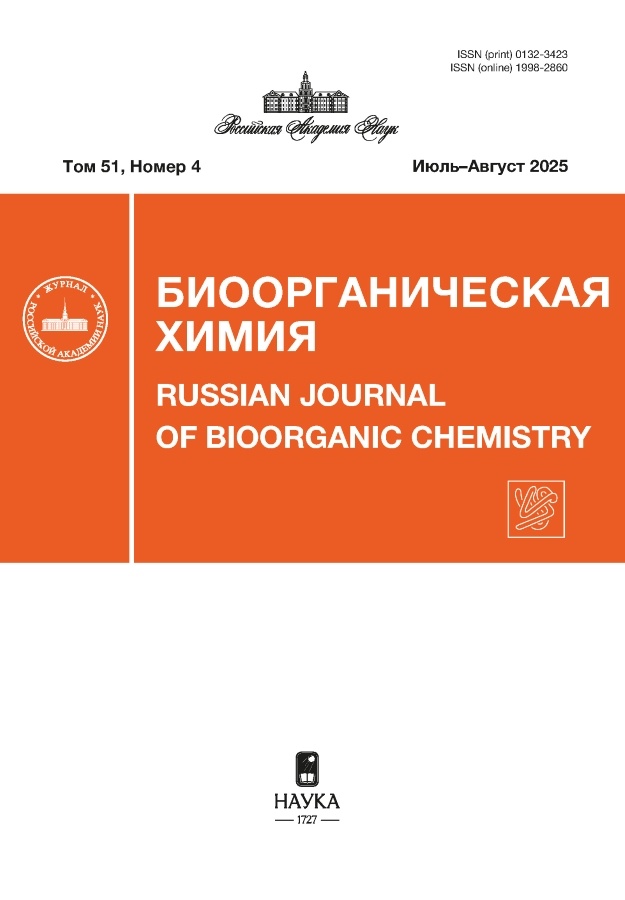Pharmacokinetic Features of Ecdystene and Ursolic Acid in Plant Extracts After Oral Administration In Vivo
- 作者: Kiseleva D.A1, An'kov S.V1, Tolstikova T.G1, Okhina A.A1,2, Rogachev A.D1,2
-
隶属关系:
- N.N. Vorozhtsov Novosibirsk Institute of Organic Chemistry SB RAS
- Novosibirsk State University
- 期: 卷 51, 编号 4 (2025)
- 页面: 644-653
- 栏目: Articles
- URL: https://rjeid.com/0132-3423/article/view/690859
- DOI: https://doi.org/10.31857/S0132342325040091
- EDN: https://elibrary.ru/LNRRTA
- ID: 690859
如何引用文章
详细
作者简介
D. Kiseleva
N.N. Vorozhtsov Novosibirsk Institute of Organic Chemistry SB RAS
Email: dasha.halikova@mail.ru
Russia, Novosibirsk
S. An'kov
N.N. Vorozhtsov Novosibirsk Institute of Organic Chemistry SB RASRussia, Novosibirsk
T. Tolstikova
N.N. Vorozhtsov Novosibirsk Institute of Organic Chemistry SB RASRussia, Novosibirsk
A. Okhina
N.N. Vorozhtsov Novosibirsk Institute of Organic Chemistry SB RAS; Novosibirsk State UniversityRussia, Novosibirsk; Russia, Novosibirsk
A. Rogachev
N.N. Vorozhtsov Novosibirsk Institute of Organic Chemistry SB RAS; Novosibirsk State UniversityRussia, Novosibirsk; Russia, Novosibirsk
参考
- Физуллия О.Ф., Льновина М.Н. // Ползунововский вестник. 2018. № 4. С. 89–94. https://doi.org/10.25712/ASTU.2072-8921.2018.04.018
- Dima C., Assadpour E., Dima S., Jafari S.M. // Compr. Rev. Food Sci. Food Saf. 2020. V. 19. P. 954–994. https://doi.org/10.1111/1541-4337.12547
- Thakur N., Raigond P., Singh Y., Mishra T., Singh B., Lal M.K., Dutt S. // Trends Food Sci. Technol. 2020. V. 97. P. 366–380. https://doi.org/10.1016/j.tifs.2020.01.019
- Liu Y., Xia H., Guo S., Li P., Qin S., Shi M., Zeng C. // Food Chem. 2023. V. 423. P. 136220. https://doi.org/10.1016/j.foodchem.2023.136220
- Kunkel S.D., Suneja M., Ebert S.M., Bongers K.S., Fox D.K., Malmberg S.E., Alipour F., Shields R.K., Adams C.M. // Cell Metab. 2011. V. 13. P. 627–638. https://doi.org/10.1016/j.cmet.2011.03.020
- Rai S.N., Yadav S.K., Singh D., Singh S.P. // J. Chem. Neuroanat. 2016. V. 71. P. 41–49. https://doi.org/10.1016/j.jchemneu.2015.12.002
- Wang L., Wang G.L., Liu J.H., Li D., Zhu D.Z., Wu L.N. // Chin. J. Integr. Med. 2012. V. 10. P. 793–799. https://doi.org/10.3736/jcim20120710
- Liu Y., Zheng J.Y., Wei Z.T., Liu S.K., Sun J.L., Mao Y.H., Xu Y.D., Yang Y. // Front. Pharmacol. 2022. V. 13. P. 969207. https://doi.org/10.3389/fphar.2022.969207
- Kornel A., Nadlie M., Reisidou M.I., Sakellakis M., Giori K., Beloukas A., Sze N.S.K., Klentrou P., Tsiani E. // Int. J. Mol. Sci. 2023. V. 24. P. 7414. https://doi.org/10.3390/ijms24087414
- Chan E.W.C., Soon C.Y., Tan J.B.L., Wong S.K., Hui Y.W. // J. Integr. Med. 2019. V. 17. P. 155–160. https://doi.org/10.1016/j.joim.2019.03.003
- Wozniak L., Szakiel A., Glowacka A., Rozpara E., Marszalek K., Skapska S. // Molecules. 2023. V. 28. P. 2584. https://doi.org/10.3390/molecules28062584
- Jager S., Trojan H., Kopp T., Laszczyk M.N., Scheffler A. // Molecules. 2009. V. 14. P. 2016–2031. https://doi.org/10.3390/molecules14062016
- Todorova V., Ivanova S., Chakarov D., Kraev K., Ivanov K. // Nutrients. 2024. V. 16. P. 1382. https://doi.org/10.3390/nu16091382
- Budesinsky M., Vokác K., Harmatha J., Cvacka J. // Steroids. 2008. V. 73. P. 502–514. https://doi.org/10.1016/j.steroids.2007.12.021
- Cheng D.M., Kutzler L.W., Boler D.D., Drnevich J., Killefer J., Lila M.A. // Phytother. Res. 2013. V. 27. P. 107–111. https://doi.org/10.1002/ptr.4679
- Kokoska L., Janovska D. // Phytochemistry. 2009. V. 70. P. 842–855. https://doi.org/10.1016/j.phytochem.2009.04.008
- Ambrosio G., Joseph J.F., Wuest B., Mazzarino M., de la Torre X., Diel P., Boiré F., Parr M.K. // Steroids. 2020. V. 157. P. 108603. https://doi.org/10.1016/j.steroids.2020.108603
- Dioh W., Tourette C., Del Signore S., Daudigny L., Dupont P., Balducci C., Dilda P.J., Lafont R., Veillet S. // J. Cachexia Sarcopenia Muscle. 2023. V. 14. P. 1259–1273. https://doi.org/10.1002/jcsm.13195
- Kraiem S., Al-Jaber M.Y., Al-Mohammed H., Al-Menhali A.S., Al-Thani N., Helaleh M., Samsam W., Touil S., Beotra A., Georgakopoulas C., Bouabdallah S., Mohamed-Ali Y., Al Maadheed M. // Drug Test Anal. 2021. V. 113. P. 1341–1353. https://doi.org/10.1002/dta.3032
- Wang X.H., Zhou S.Y., Qian Z.Z., Zhang H.L., Qiu L.H., Song Z., Zhao J., Wang P., Hao X.S., Wang H.Q. // Expert Opin. Drug Metab. Toxicol. 2013. V. 9. P. 117–125. https://doi.org/10.1517/17425255.2013.738667
- Zhu Z., Qian Z., Yan Z., Zhao C., Wang H., Ying G. // Int. J. Nanomedicine. 2013. V. 8. P. 129–136. https://doi.org/10.2147/IJN.S38271
- Qian Z., Wang X., Song Z., Zhang H., Zhou S., Zhao J., Wang H. // Biomed. Res. Int. 2015. V. 2015. P. 809714. https://doi.org/10.1155/2015/809714
- Chen Q., Luo S., Zhang Y., Chen Z. // Anal. Bioanal. Chem. 2011. V. 399. P. 2877–2884. https://doi.org/10.1007/s00216-011-4651-x
- Zhang C., Wang C., Li W., Wu R., Guo Y., Cheng D., Yang Y., Androulakis I.P., Kong A.N. // Mol. Pharm. 2017. V. 14. P. 3709–3717. https://doi.org/10.1021/acs.molpharmaceut.7b00469
- Younige A.B., Ихалайнен А.А., Максимов В.А. // Фармакология. 2014. № 15. С. 250–262.
- Lafont R., Dilda P., Dupont P., Signore S.D., Veillet S. // Patent FR 3065644 A1, 2020.
- Namdeo P., Gidwani B., Tiwari S., Jain V., Joshi V., Shukla S.S., Pandey R.K., Vyss A. // J. Sci. Food Agric. 2023. V. 103. P. 4275–4292. https://doi.org/10.1002/jsfa.12423
- Epимбенов К.Т., Федорова А.В., Гончарова А.Я., Бондаренко Е.В. // Проблемы биологии продуктивных животных. 2020. № 3. С. 106–113. https://doi.org/10.25687/1996-6733.prodanimbiol.2020.3.106-113
- Dinan L., Balducci C., Guibout L., Foucault A.S., Bakrim A., Kumpun S., Girault J.P., Tourette C., Dioh W., Dilda P.J., Veillet S., Lafont R. // J. Steroid Biochem. Mol. Biol. 2021. V. 212. P. 105896. https://doi.org/10.1016/j.jsbmb.2021.105896
- Tai M.M. // Diabetes Care. 1994. V. 17. P. 152–154. https://doi.org/10.2337/diacare.17.2.152
补充文件









